Let’s take a peek at another facet of impaired function, the indicator of which, I affectionately call “Bulb Butt”.
“Oh my God, Becky. Look her bulbs!” or “Do these shoes make my bulbs look big?”
In one of my first blogs, I had used a picture for illustrative purpose that also happened to have contracted heels. It gave the appearance of a plumber’s crack or a “bulb butt” on the back of the horse’s hoof. Here would be some examples of what I am talking about:
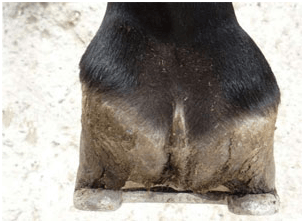
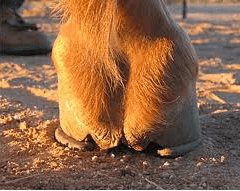

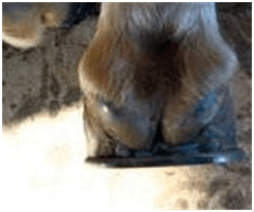
Now, you can get a crack on a horse, due to really, really bad thrush. That looks ,more like this:
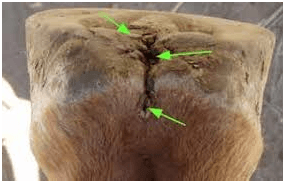
This Thrush Crack can happen on any foot, so you would have to check out whether it was a Bulb Butt, as laid out below, or whether it was a “Grand Canyon” of erosion caused by the frog having a severe case of thrush.
Back to the Bulb Butt.
Let’s look at human feet. Below you can see a bare foot. Left to its own devices, it has a width it prefers. If I put on a slightly tight shoe, my foot would accommodate it and bend.

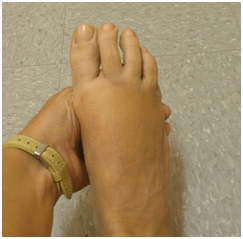
From the solar view of my foot, you can see the foot in a flat, neutral position, and then you can see a crease, as it is squished. It didn’t “become” narrower, it’s just squished.
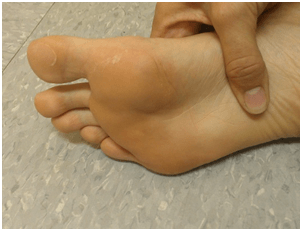

It’s like trying to squish your foot into a shoe that doesn’t fit. You can see the base width of the hoofwall marked in orange. You can see how the bulbs squish up and “over” the hoofwall that supports it from beneath. We can see that the frog is actually “behind” the heels. If I had a solar view, I am betting the heel had moved forward to support the horse. Seeing the metal on both sides, I can see how far around that shoe is wrapping and how narrow the frog is.
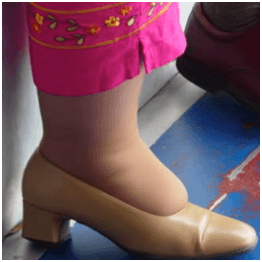

How come we can glance at that woman’s shoe and “feel” how tight her foot is squished and yet we can’t look at a horse and have the same instant assessment? We need to educate our eyes. Let’s see it side by side. A horse has a heel width he would like to maintain. With shoes, it maintained it too narrow and you can see how narrow the heel is, how narrow the frog is, how pushed up the bulbs are and the tell-tale “V” that the hairline will make.
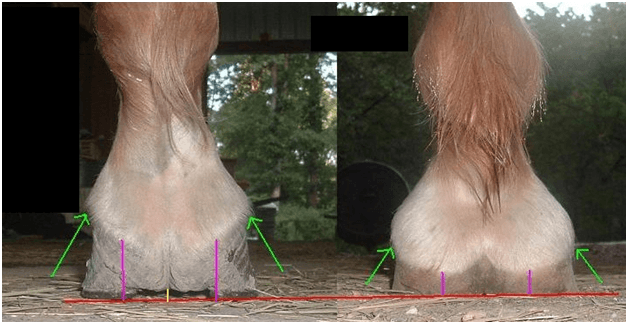
Let’s say a horse has “2 inches” of hairline along the left and right side of the heel. If it can’t go horizontal, it’s going to creep vertical. Can you see it there below? I know they are two different horses, but I measured exactly the same “length” of blue marker and applied it to both feet. What’s amazing is they both had 2.75” of “hairline”. One is just horizontal and one is vertical. The more horizontal one was a wider foot, not jammed up.
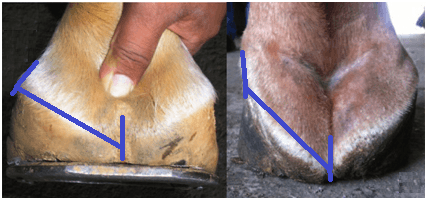
When I see Bulb Butt from the top, I know I will see this on the solar view:
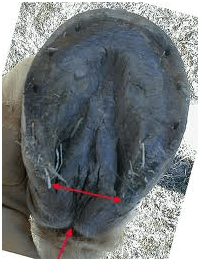
In our previous blogs, we’ve covered that the hoofwall is not flexible. It’s a solid wall. The frog can flex and that allows the heels to move and the over-all hoof to shift its form a smidge. Additionally, we covered that they don’t have a rotating ankle like we do, it only flips and flops up and down. So those heels need to be able to move to adapt with as much range of flex that they can to accommodate the surface of the ground. With the digital cushion inside the hoof directly above that frog, they’ve got some cushion to work with. Those narrow heels mean a lot more rigid hoofwall and a much smaller range of flex in the heels. Couple that with a metal shoe and there is not a ton of flexing that hoof can do.
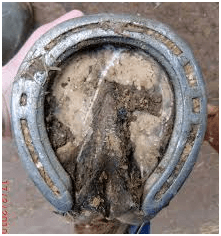
There are three parts of man-made interference here that a farrier will try to compensate for:
1) 99% of our horses are not on a varied terrain for enough hours to build up a wild-horse sole callous.
That’s on us. Whether we put them in a stall, or a dry field, or don’t ride them or or or. That’s on us. I love running barefoot. I can’t run truly barefoot, because I have no callous on my foot. I know a tribal messenger in South Africa that ran up to 100 miles a day and knew 32 different tribal dialects. He ran messages from tribe to tribe. He had a fantastic sole callous. His “job” allowed for this lifestyle. I work in an office building, in a city. I am not spending 24 hours of my life barefoot AND active. I won’t build a sole callous like he will. I don’t need Nikes, I can still run in a barefoot slipper, but I need *something* on the bottom of my foot to survive blistering pavement and rocky trails.

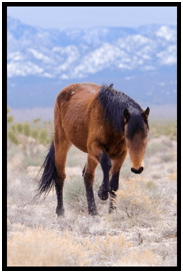
2) Our horses’ hooves grow in a cone-like path or trajectory, getting wider as they get longer, yet we normally fit them in fixed-size devices that limit the expansion their hoof goes through during a trimming cycle.
That’s on us. Ask any parent of a 5yr old and ask them how quickly they grow through shoes. Our fuzzy kids grow through a size or two, get a trim, then grow back out a size or two and then get a trim. A child can pout, take their shoes off and indicate that they don’t want them on.
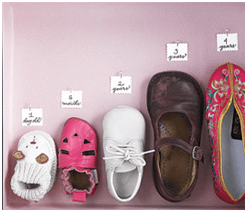
If they couldn’t remove them, what would happen to their “growing” foot if left in a shoe that didn’t grow? We all have that friend with slightly odd looking feet because of their running shoes, their high heels or their lifelong passion for wearing $1 flip-flops.
But to be more accurate, as it’s not their “foot” that is growing, but their nail, I guess it would be like this guy trying to size himself for running shoes (hint, I’m *pretty* sure he’s going to need two sizes larger than he should to accommodate those toenails):
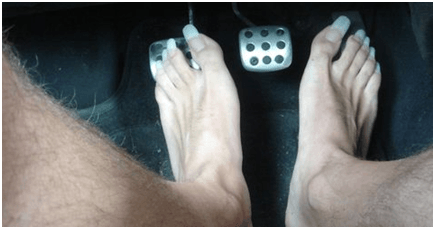
3) Lastly, we trim them how we trim them, rightly or wrongly. We might be great trimmers or we might be horrible trimmers, but we are trying to take off portions of their hoof that would’ve worn off naturally. We can cause issues by our crappy trims. We can cause issues by not seeing what improves the horse, what helps them move more freely, what trims make them happier.
Remember the too long, sloped toe and the underrun heel? That’s on us to see and trim.
Remember the too tall heels and the circular-wider foot? That’s on us to see and trim.
So get out and explore! Go look at the hooves on your horse and see what you can see. Challenge yourself to “see” what’s happening IN the hoof, from what you can see on the outside. Educate yourself more on hooves and their function. Go look at other horse’s feet in your barn. Go check out the neighbor’s horse’s hooves.
There is no reason you shouldn’t be an expert.
If you can spot a saddle put on wrong from across a yard, a bridle put on backwards, a horse not tied correctly or a gate not shut properly then you have a trained eye. Now you just need to train it in hooves until you feel just as confident in spotting good from bad.
I’m not the expert, I am just passionate. I will keep sharing with you the basics that I find fascinating.
Holly Jonsson

Director of Sales
Through a lifetime of “horse crazy” and the fortunate experience of riding nearly every shape and size of horse, I got to see a wide array of hoof shapes and sizes. No Hoof, No Horse is very true to me. I want to ensure that horses on every continent have a variety of footwear to pick from, to ensure the best match is found. I want your partner to be happy from the ground up!





